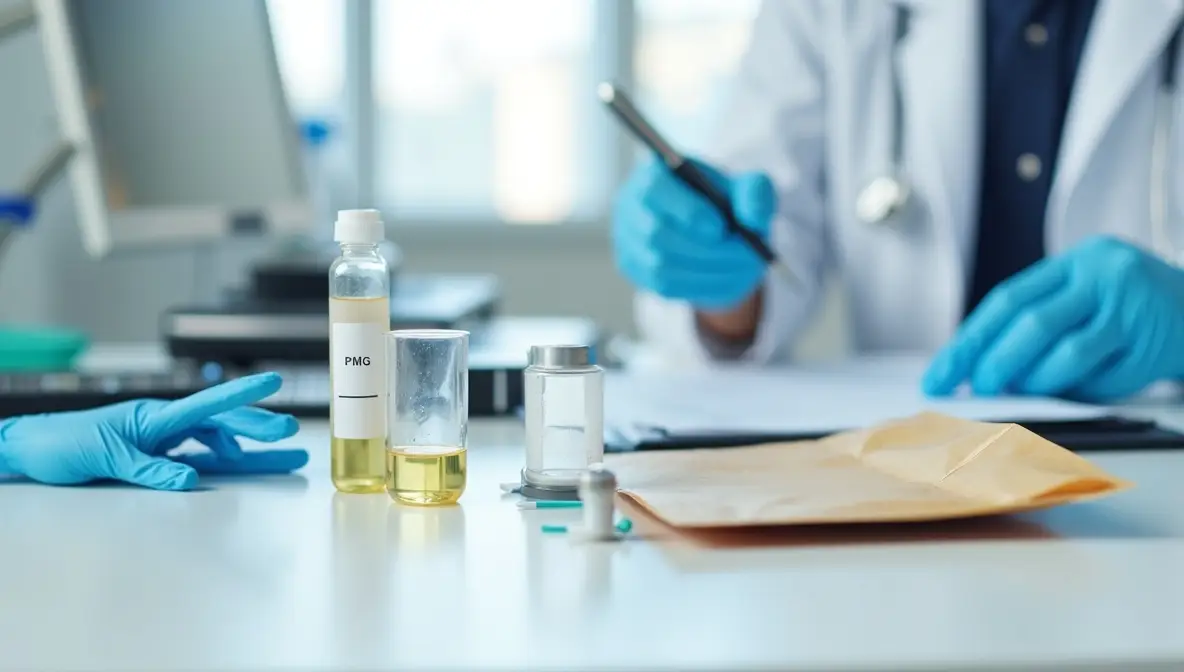Drug detection times vary significantly based on the substance type, testing method, and individual factors like metabolism and body composition. Understanding these timeframes is crucial for job seekers preparing for employment screening and employers implementing compliant testing policies.
Key Takeaways
- Different substances have varying detection windows, from hours to months depending on the drug and testing method used
- Urine tests are the most common employment screening method, detecting most drugs for 1-30 days after use
- Hair follicle tests have the longest detection window, identifying drug use up to 90 days prior
- Individual factors like body weight, metabolism, hydration, and frequency of use significantly impact detection times
- Employers must follow federal and state regulations when implementing workplace drug testing programs
- Job seekers should be aware of industry-specific testing requirements and prepare accordingly for pre-employment screenings
Understanding Employment Drug Testing Basics
Pre-employment drug screening has become standard practice across many industries today. Most job seekers will encounter drug testing at some point in their career journey. Understanding what to expect helps reduce anxiety and improves preparation for the hiring process. The drug detection times chart provides essential information for employment success.
Employers use drug testing to ensure workplace safety and reduce liability risks. They want to hire reliable employees who can perform their duties safely. Drug testing also helps companies comply with federal regulations and insurance requirements. Many industries require testing by law for certain positions.
Job seekers should view drug testing as a normal part of the employment process. Preparation and understanding help ensure positive outcomes during job applications. Knowledge about testing methods and detection windows prevents surprises during hiring. This information helps candidates make informed decisions about their job search timing.
Common Testing Scenarios
Most job seekers encounter drug testing during the final stages of hiring. Employers typically extend conditional job offers before requiring testing. This means you have already impressed them with your qualifications and interview performance. The drug test serves as a final verification step before official employment begins.
Some positions require testing at multiple points during employment. Pre-employment testing happens before starting work officially. Random testing may occur throughout employment without advance warning. Post-accident testing follows workplace injuries or incidents immediately.
Comprehensive Drug Detection Times Chart
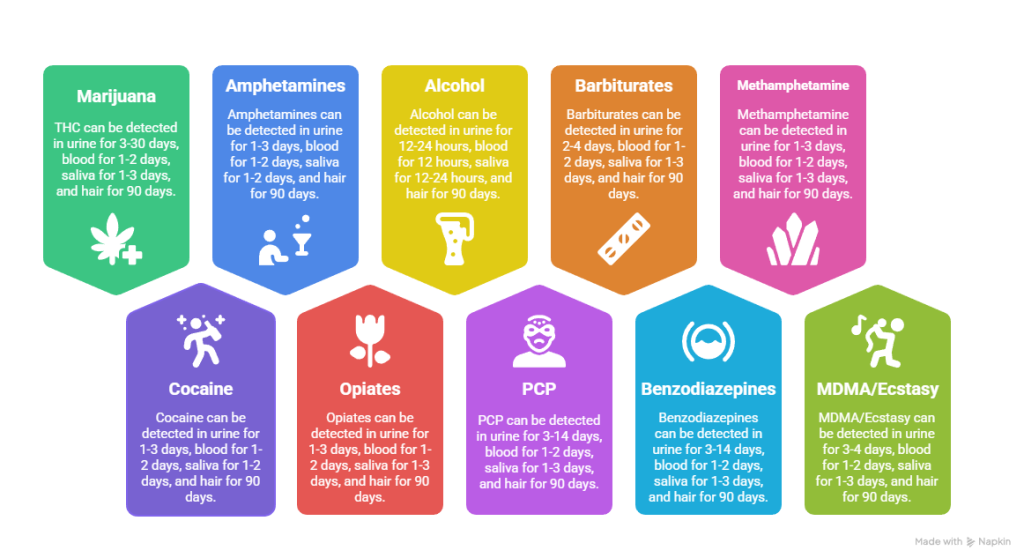
The drug detection times chart below shows how long different substances remain detectable in your system. These timeframes directly impact job search strategies and employer testing decisions. Understanding detection windows helps both parties plan appropriately for employment processes. Different testing methods have significantly different detection capabilities and timeframes.
Individual factors can extend or shorten these detection periods considerably. Personal timelines may differ from the ranges shown below. Heavy users typically face longer detection windows than occasional users. First-time users often clear substances faster than the minimum timeframes listed.
| Substance | Urine Test | Blood Test | Saliva Test | Hair Test |
| Marijuana (THC) | 3-30 days | 1-2 days | 1-3 days | 90 days |
| Cocaine | 1-3 days | 1-2 days | 1-2 days | 90 days |
| Amphetamines | 1-3 days | 1-2 days | 1-2 days | 90 days |
| Opiates | 1-3 days | 1-2 days | 1-3 days | 90 days |
| Alcohol | 12-24 hours | 12 hours | 12-24 hours | 90 days |
| PCP | 3-14 days | 1-2 days | 1-3 days | 90 days |
| Barbiturates | 2-4 days | 1-2 days | 1-3 days | 90 days |
| Benzodiazepines | 3-14 days | 1-2 days | 1-3 days | 90 days |
| Methamphetamine | 1-3 days | 1-2 days | 1-3 days | 90 days |
| MDMA/Ecstasy | 3-4 days | 1-2 days | 1-3 days | 90 days |
This drug detection times chart serves as a planning reference guide for both groups. Job seekers should use maximum timeframes for safety when planning applications. Employers can reference these windows when selecting appropriate testing methods.
Factors Affecting Detection Times
Individual drug detection times chart results depend on several personal factors. Body composition plays a major role in how long substances remain detectable. People with higher body fat may retain substances longer than lean individuals. Age and overall health also influence how quickly bodies process substances.
Usage patterns significantly impact detection timeframes for all individuals tested. Single-use incidents typically clear within minimum timeframes shown above. Regular use creates accumulation that extends detection windows considerably. Heavy daily use can result in positive tests weeks after stopping completely.
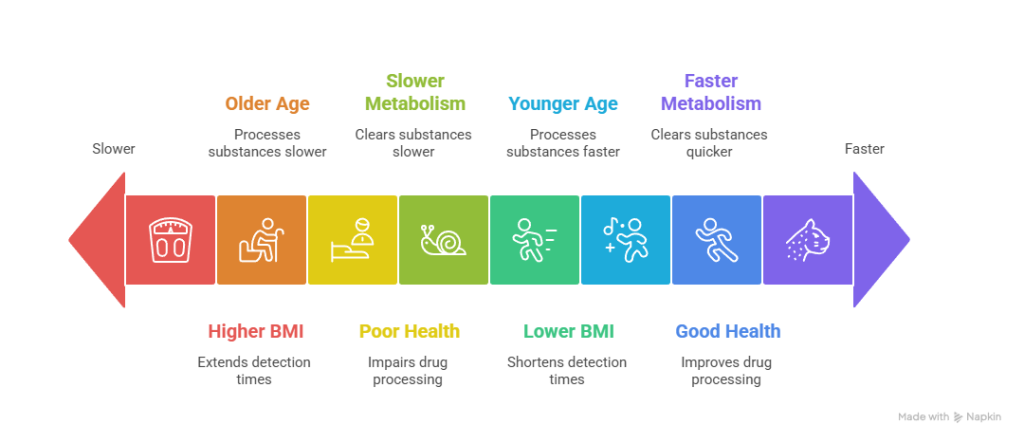
- Body weight and composition: Higher BMI may extend detection times
- Metabolism rate: Faster metabolism typically clears substances quicker
- Hydration levels: Proper hydration supports natural detoxification processes
- Exercise habits: Regular physical activity may slightly improve clearance
- Overall health: Kidney and liver function affect drug processing speeds
- Age factors: Younger people often process substances faster than older adults
Understanding these factors helps estimate personal detection timelines. Conservative estimates protect against unexpected positive results during employment screening.
Types of Employment Drug Tests
Job seekers encounter several different testing methods during employment searches. Employers choose from these same methods based on their specific needs. Each method has advantages and detection capabilities that serve different purposes. Understanding these differences helps both groups prepare appropriately for testing situations.
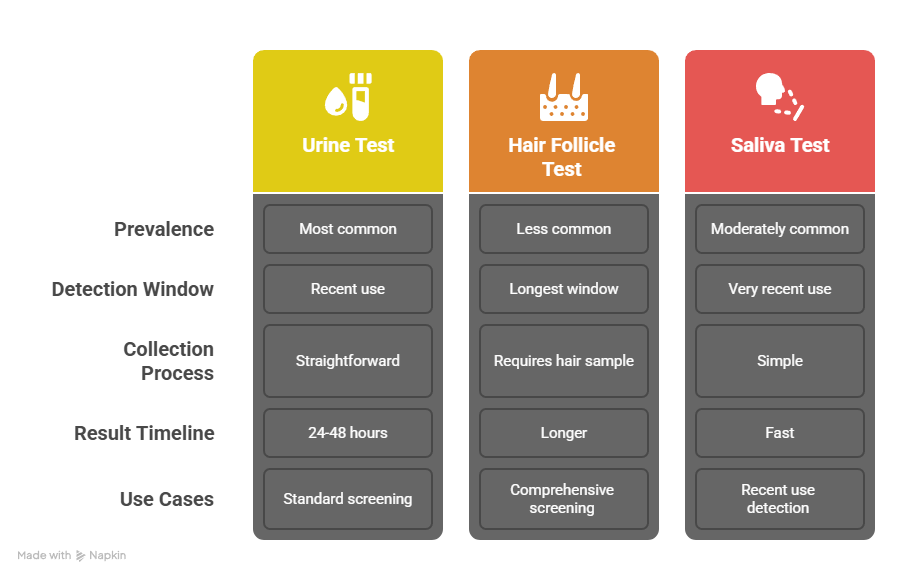
Most employers choose testing methods based on cost and industry requirements. Safety-sensitive positions often require more comprehensive testing approaches than standard office jobs. Federal regulations may mandate specific testing methods for certain industries. Company policies and insurance requirements also influence testing method selection significantly.
Urine Drug Testing
Urine testing represents approximately 90% of all employment drug screening nationwide. This method offers reliable results at reasonable costs for employers. Most job seekers will encounter urine testing during their employment search process. The collection process is straightforward and typically takes just minutes to complete.
Urine tests detect recent substance use effectively within their detection windows. They provide good balance between recency and detection period for employers. Most standard employment screens test for 5 or 10 substances simultaneously. Results are typically available within 24-48 hours for hiring decisions.
Hair Follicle Testing
Hair follicle testing provides the longest detection window available for employment screening. This method can identify substance use up to 90 days before testing. Safety-sensitive industries often prefer hair testing for comprehensive screening capabilities. Transportation, healthcare, and government positions frequently require hair follicle testing.
The collection process requires about 1.5 inches of hair for accurate testing. Head hair is preferred, but body hair can substitute if necessary. The test detects drug metabolites that become trapped in hair structure. This creates a longer-term record of substance use patterns over time.
Saliva Drug Testing
Saliva testing detects very recent substance use more effectively than other methods. This makes it valuable for detecting current impairment or recent consumption. Some employers use saliva testing for reasonable suspicion or post-accident situations. The collection process is simple and can be observed directly easily.
Detection windows for saliva testing are typically shorter than urine testing. Most substances clear from saliva within 1-3 days after use. This limits effectiveness for standard pre-employment screening purposes. However, it provides valuable information about recent use patterns effectively.
Industry-Specific Testing Requirements
Different industries maintain varying drug testing standards that affect both job seekers and employers. Understanding target industry requirements helps with career planning and preparation. Some fields have mandatory federal testing requirements that cannot be avoided. Others rely on company policies that may vary between employers significantly.
Researching industry standards before job searching or hiring helps appropriate preparation. Safety-sensitive industries typically have stricter requirements than office environments. Government positions often require comprehensive background checks including extensive drug testing. Healthcare workers face unique challenges due to patient safety concerns.
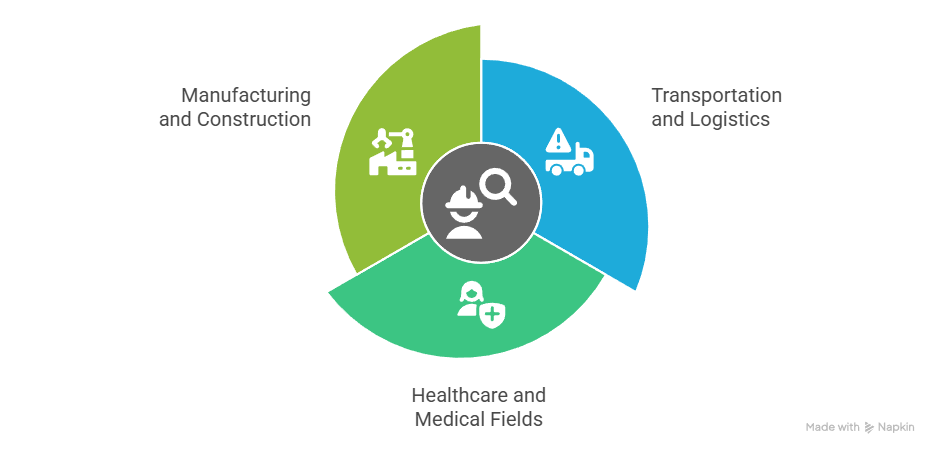
Transportation and Logistics
Transportation industry careers require compliance with Department of Transportation regulations. Commercial drivers, pilots, and railroad workers must pass pre-employment testing. They also face ongoing random testing throughout their careers. DOT violations can end transportation careers permanently in many cases.
DOT testing uses specific 5-panel urine screens for marijuana, cocaine, amphetamines, opiates, and PCP. Hair follicle testing is becoming more common as additional screening. Some companies test for alcohol separately from the standard DOT panel. Return-to-duty programs exist but are expensive and time-consuming.
Healthcare and Medical Fields
Healthcare careers require drug testing due to patient safety responsibilities. Access to controlled substances creates additional screening requirements for medical professionals. Licensing boards may require separate testing beyond employer requirements. Even minor violations can affect professional licenses and career prospects permanently.
Healthcare testing often includes expanded panels beyond standard employment screening. This covers prescription drug abuse and additional controlled substances. Professional licensing consequences can be more severe than employment termination alone. Background checks typically accompany drug testing in healthcare settings comprehensively.
Manufacturing and Construction
Industrial careers in manufacturing and construction often require drug testing. Heavy machinery operation and workplace safety drive these testing requirements. High-injury environments make drug testing a liability protection measure for employers. Union agreements may influence testing policies and procedures significantly.
Testing requirements vary significantly between companies and job roles within industries. Permanent employees might face different requirements than contractors or temporary workers. Safety-sensitive equipment operation typically triggers more frequent testing protocols. Workplace accidents usually result in immediate testing for all involved parties.
Legal Rights and Protections
Both job seekers and employers must understand legal rights and obligations regarding drug testing. Federal and state laws provide protections against discrimination and privacy violations. However, these protections have limitations that both parties should understand clearly. Compliance with legal requirements protects everyone involved in the process.
Legal requirements vary significantly between states regarding testing procedures and protections. Some states provide additional protections beyond federal minimum standards. Others give employers broad discretion in testing program implementation and consequences. Knowing applicable laws helps ensure proper treatment during processes.
Job Seeker Rights
Job seekers maintain specific legal rights throughout employment drug testing processes. Privacy rights during collection and result handling are protected by law. Test results must be kept confidential and cannot be shared unnecessarily. Only authorized personnel can access testing information and results appropriately.
The collection process must respect dignity while ensuring sample integrity. Private facilities and professional staff are required for testing procedures. Candidates cannot be subjected to unreasonable search or surveillance during collection. Chain of custody procedures protect both privacy and sample authenticity.
Medical conditions and prescription medications receive special consideration during testing. Prescription drugs should be disclosed to medical review officers, not employers directly. Medical review officers evaluate positive results before reporting to employers. Valid prescriptions can prevent employment consequences from positive test results.
Employer Obligations
Employers have the right to maintain drug-free workplaces but must follow specific legal procedures. They must provide clear policies and follow consistent procedures for all candidates. Privacy rights must be respected during testing processes throughout. Written consent and proper notification are typically required before testing begins.
Companies must use certified laboratories for legally defensible results consistently. Chain of custody procedures must be maintained throughout testing processes. Medical review officers must evaluate positive results before employer reporting. Accommodation requirements may apply for prescription medication users in certain situations.
Strategic Planning for Both Parties
Understanding drug detection timeframes allows informed employment preparation decisions for career success. The most effective strategy involves maintaining sobriety before beginning job searches. This is especially important in industries with comprehensive testing requirements consistently. Different substances require different preparation timeframes based on detection windows shown.
Job seekers should research target industry typical testing practices for appropriate preparation. This helps determine suitable preparation timelines for applications and interviews. Safety-sensitive positions and government roles typically require longer preparation periods. They often use more extensive testing protocols than standard office positions.
Timeline Planning
Effective preparation requires understanding maximum detection windows rather than minimum timeframes consistently. Most substances clear from urine within 30 days for occasional users. However, heavy users may need 60-90 days or longer for complete clearance. Hair follicle testing extends this timeline to at least 90 days minimum.
Different job search strategies require different preparation approaches for optimal success. Active job searching with immediate applications needs longer lead times for safety. Passive job searching allows for more flexible timing approaches throughout the process. Emergency job searches may limit available preparation time significantly for candidates.
- Conservative planning: Use maximum detection times for safety margins consistently
- Industry research: Understand typical testing methods in target fields thoroughly
- Flexible strategies: Adapt timing based on available opportunities and requirements
- Documentation maintenance: Keep records of preparation activities and timeline progress
- Professional development: Use preparation time for skill building and networking activities
Strategic planning helps ensure testing success while maintaining career momentum effectively throughout the process.
Cost Considerations for Employers
Employer testing costs influence program design and candidate experiences in several ways. Budget constraints may limit testing comprehensiveness but rarely eliminate programs completely. Companies with limited budgets often choose less expensive urine testing over comprehensive hair testing. This affects drug detection times chart planning that job seekers need for applications.
Larger employers often negotiate volume discounts that allow more comprehensive testing programs. They may use multiple testing methods or expanded panels for thorough screening coverage. Smaller companies might rely on basic testing that costs less but provides adequate screening. Understanding company size helps predict likely testing approaches and requirements.
| Test Type | Cost Range | Processing Time | Best Use Case |
| Urine 5-Panel | $25-50 | 24-48 hours | Standard pre-employment screening |
| Urine 10-Panel | $50-80 | 24-48 hours | Comprehensive screening programs |
| Hair Follicle | $100-150 | 3-5 days | Safety-sensitive positions |
| Saliva Test | $20-40 | 24 hours | Reasonable suspicion testing |
Cost considerations affect testing timing and scheduling flexibility for both parties involved. Batch processing of tests may create delays in hiring decisions and candidate communication. Rush processing costs extra and may not be available for all positions.
Conclusion
Successfully navigating employment drug testing requires understanding detection times, testing methods, and industry-specific requirements that affect both job seekers and employers in today's workplace environment. The comprehensive drug detection times chart provided serves as a strategic planning foundation for job seekers while helping employers make informed decisions about testing program implementation and procedures. Smart preparation using conservative timeframes, combined with professional development during waiting periods, ensures optimal outcomes for all parties involved in the employment screening process.
Frequently Asked Questions
How accurate are drug detection time charts for employment planning?
Drug detection time charts provide general guidelines based on average detection windows, but individual results can vary significantly based on personal factors. Metabolism, body composition, hydration levels, and frequency of use can extend or shorten detection periods considerably. Job seekers should use maximum timeframes for planning and treat charts as conservative reference tools rather than definitive timelines.
What should job seekers do about prescription medications during employment testing?
Job seekers should disclose prescription medications to the medical review officer during the testing process, not to employers directly. Medical review officers evaluate positive results and consider legitimate medical explanations before reporting to employers. Maintain proper documentation from healthcare providers and bring current prescription bottles to support legitimate medication use claims.
How long should job seekers wait before applying if they've used substances?
Job seekers should allow for maximum detection windows rather than minimum timeframes when planning their job application timeline strategically. For most substances, waiting 30-90 days provides adequate clearance for standard employment testing, though hair follicle tests require 90+ days of preparation time. Safety-sensitive positions may warrant even longer preparation periods.
What testing methods do most employers use for pre-employment screening?
Approximately 90% of employers use urine testing for pre-employment screening due to its cost-effectiveness and reliable detection capabilities. Hair follicle testing is used by about 10-15% of employers, primarily in safety-sensitive industries like transportation and healthcare. Saliva testing is less common for pre-employment but may be used for reasonable suspicion situations.
Which industries require the most comprehensive drug testing for job applicants?
Transportation (DOT-regulated), healthcare, government/security clearance positions, and manufacturing typically require the most comprehensive drug testing programs. These industries often use hair follicle testing, expanded drug panels, and ongoing random testing throughout employment periods. Construction, utilities, and other safety-sensitive industries also maintain strict testing requirements.
Can employers test for different substances beyond the standard panels?
Yes, employers can test for additional substances beyond standard 5-panel or 10-panel drug screens, though this increases costs significantly. Extended panels may include synthetic drugs, additional prescription medications, or alcohol testing depending on industry requirements and company policies. However, most employers stick to standard panels for cost-effectiveness.
Additional Resources
- Substance Abuse and Mental Health Services Administration (SAMHSA) Guidelines
https://www.samhsa.gov/workplace/resources/drug-testing - Department of Transportation Drug Testing Regulations
https://www.transportation.gov/odapc/drug-testing-regulations - Equal Employment Opportunity Commission Guidance on Drug Testing
https://www.eeoc.gov/laws/guidance/ada-disability-related-inquiries-medical-examinations-employees - National Institute on Drug Abuse Workplace Resources
https://nida.nih.gov/drug-topics/workplace-resources - Society for Human Resource Management Drug Testing Resources
https://www.shrm.org/resourcesandtools/tools-and-samples/toolkits/pages/drugtesingintheworkplace.aspx
Still have questions?
Get in touch with our team today for a personalized demo and discover how our tailored volume pricing and packages can drive results for your business!
How useful was this page?*
Note: your comments are anonymous. We use them to improve the website. Do not include any personal details.
Visit our FCRA Compliance Tool or leave a message here if you need a response.
From the blog Explore the GCheck Content Hub

How Long Does a Background Check Take? A Complete 2025 Guide
13 Dec, 2023 • 14 min read
The Ultimate Background Check Guide
13 Dec, 2023 • 4 min read
The Ultimate Guide to Employment Background Checks
13 Dec, 2023 • 10 min readThe information provided in this article is for general informational and educational purposes only and should not be construed as legal advice or a substitute for consultation with qualified legal counsel. While we strive to ensure accuracy, employment screening laws and regulations—including but not limited to the Fair Credit Reporting Act (FCRA), Equal Employment Opportunity Commission (EEOC) guidelines, state and local ban-the-box laws, industry-specific requirements, and other applicable federal, state, and local statutes—are subject to frequent changes, varying interpretations, and jurisdiction-specific applications that may affect their implementation in your organization. Employers and screening decision-makers are solely responsible for ensuring their background check policies, procedures, and practices comply with all applicable laws and regulations relevant to their specific industry, location, and circumstances. We strongly recommend consulting with qualified employment law attorneys and compliance professionals before making hiring, tenant screening, or other decisions based on background check information.
